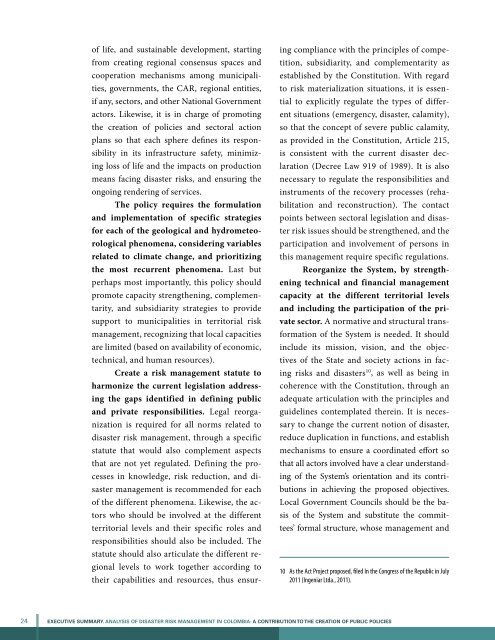Executive Summary - GFDRR
Executive Summary - GFDRR
Executive Summary - GFDRR
Create successful ePaper yourself
Turn your PDF publications into a flip-book with our unique Google optimized e-Paper software.
of life, and sustainable development, starting<br />
from creating regional consensus spaces and<br />
cooperation mechanisms among municipalities,<br />
governments, the CAR, regional entities,<br />
if any, sectors, and other National Government<br />
actors. Likewise, it is in charge of promoting<br />
the creation of policies and sectoral action<br />
plans so that each sphere defines its responsibility<br />
in its infrastructure safety, minimizing<br />
loss of life and the impacts on production<br />
means facing disaster risks, and ensuring the<br />
ongoing rendering of services.<br />
The policy requires the formulation<br />
and implementation of specific strategies<br />
for each of the geological and hydrometeorological<br />
phenomena, considering variables<br />
related to climate change, and prioritizing<br />
the most recurrent phenomena. Last but<br />
perhaps most importantly, this policy should<br />
promote capacity strengthening, complementarity,<br />
and subsidiarity strategies to provide<br />
support to municipalities in territorial risk<br />
management, recognizing that local capacities<br />
are limited (based on availability of economic,<br />
technical, and human resources).<br />
Create a risk management statute to<br />
harmonize the current legislation addressing<br />
the gaps identified in defining public<br />
and private responsibilities. Legal reorganization<br />
is required for all norms related to<br />
disaster risk management, through a specific<br />
statute that would also complement aspects<br />
that are not yet regulated. Defining the processes<br />
in knowledge, risk reduction, and disaster<br />
management is recommended for each<br />
of the different phenomena. Likewise, the actors<br />
who should be involved at the different<br />
territorial levels and their specific roles and<br />
responsibilities should also be included. The<br />
statute should also articulate the different regional<br />
levels to work together according to<br />
their capabilities and resources, thus ensuring<br />
compliance with the principles of competition,<br />
subsidiarity, and complementarity as<br />
established by the Constitution. With regard<br />
to risk materialization situations, it is essential<br />
to explicitly regulate the types of different<br />
situations (emergency, disaster, calamity),<br />
so that the concept of severe public calamity,<br />
as provided in the Constitution, Article 215,<br />
is consistent with the current disaster declaration<br />
(Decree Law 919 of 1989). It is also<br />
necessary to regulate the responsibilities and<br />
instruments of the recovery processes (rehabilitation<br />
and reconstruction). The contact<br />
points between sectoral legislation and disaster<br />
risk issues should be strengthened, and the<br />
participation and involvement of persons in<br />
this management require specific regulations.<br />
Reorganize the System, by strengthening<br />
technical and financial management<br />
capacity at the different territorial levels<br />
and including the participation of the private<br />
sector. A normative and structural transformation<br />
of the System is needed. It should<br />
include its mission, vision, and the objectives<br />
of the State and society actions in facing<br />
risks and disasters 10 , as well as being in<br />
coherence with the Constitution, through an<br />
adequate articulation with the principles and<br />
guidelines contemplated therein. It is necessary<br />
to change the current notion of disaster,<br />
reduce duplication in functions, and establish<br />
mechanisms to ensure a coordinated effort so<br />
that all actors involved have a clear understanding<br />
of the System’s orientation and its contributions<br />
in achieving the proposed objectives.<br />
Local Government Councils should be the basis<br />
of the System and substitute the committees’<br />
formal structure, whose management and<br />
10 As the Act Project proposed, filed In the Congress of the Republic in July<br />
2011 (Ingeniar Ltda., 2011).<br />
24 EXECUTIVE SUMMARY. ANALYSIS OF DISASTER RISK MANAGEMENT IN COLOMBIA: A contribution TO the creation of public policies

















